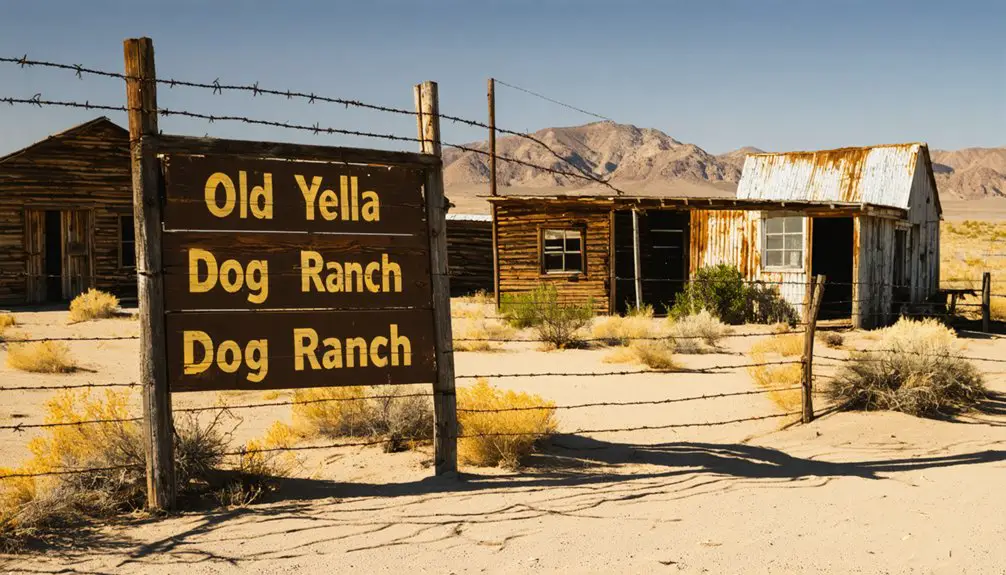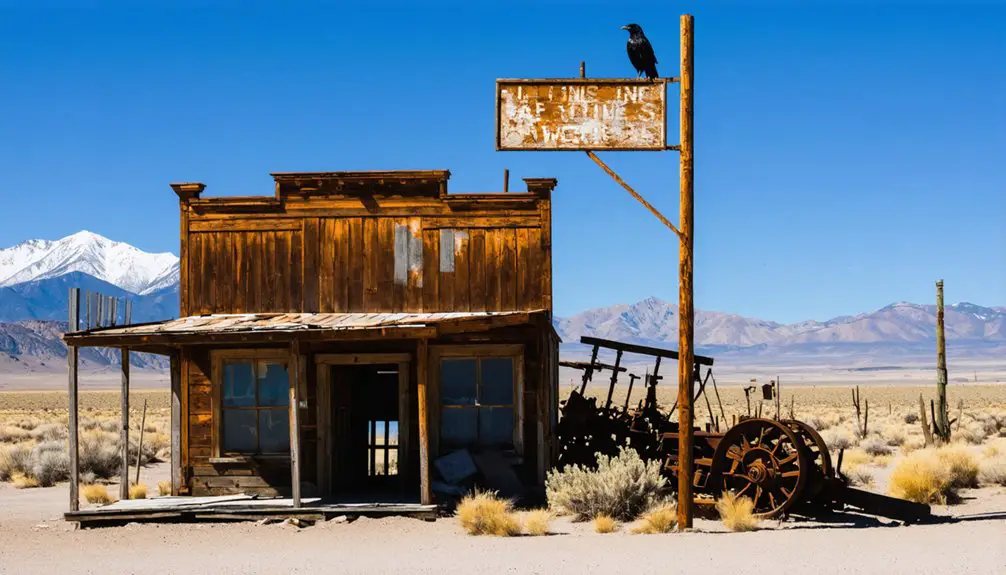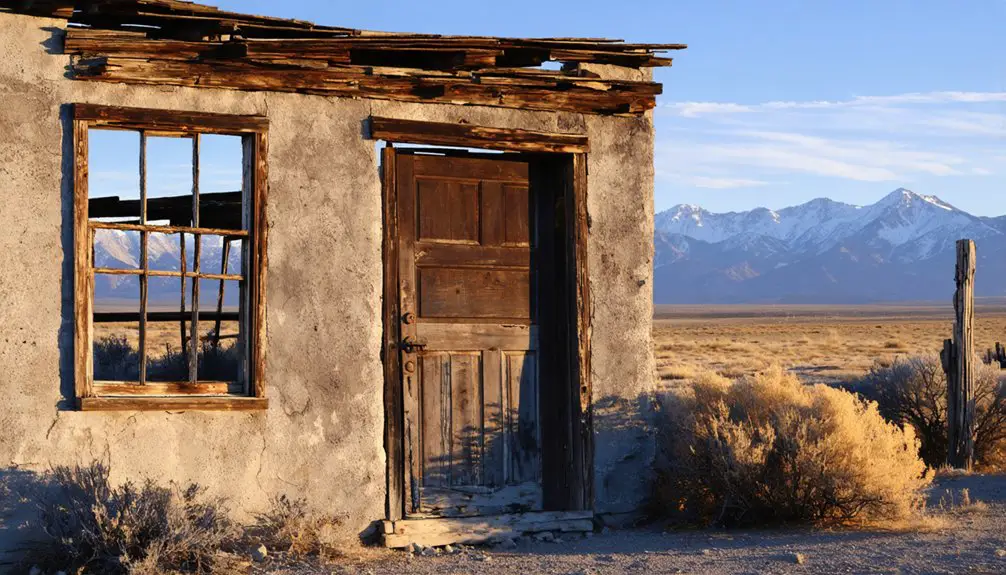You’ll find Vya’s weathered wooden structures in northwestern Washoe County, Nevada, where hopeful homesteaders settled in the early 1900s. Named after pioneer Roy Wimer’s daughter, this ghost town peaked around 1915 with a school and store, but dwindled to just 25 households by 1930. Today, you can explore the remaining buildings, including the historic Sharp place and bunkhouses owned by the Old Yella Dog Ranch and Cattle Company. The site’s remote desert location holds countless stories of ranching resilience and pioneer determination.
Key Takeaways
- Vya was established in the early 1900s, named after settler Vya Wimer, but declined to just 25 households by 1930 due to harsh conditions.
- Located 25 minutes east of Cedarville at coordinates 41º 35′ 24.46″ N, 119º 51′ 29.00″ W, accessible via Route 8A through northwestern Washoe County.
- Two remaining buildings owned by Old Yella Dog Ranch and Cattle Company stand alongside the historic Sharp place and mid-20th century bunkhouses.
- The ghost town requires high-clearance vehicles, essential supplies, and careful preparation due to minimal cellular coverage and seasonal road conditions.
- Visitors can explore portions of the historic Lassen-Applegate Trail near Vya, with visible wagon routes at the Rockin’ TD Ranch.
The Last Remnants of a Desert Outpost
Weathered wooden structures stand as silent sentinels of Vya’s past, with just two buildings remaining from the town’s early 20th-century settlement period.
These historical landmarks, now owned by the Old Yella Dog Ranch and Cattle Company, serve as rare physical reminders of desert survival in Nevada’s frontier era.
You’ll find mid-20th century bunkhouses still visible in the Vya yard area, documented in 1960s photographs.
While the original post office structure near the community pond no longer exists, the Sharp place – once home to a local sheriff and maintenance station – remains as a point of interest.
The ranch now maintains these historic features while offering rustic accommodations, allowing you to experience the authentic solitude that early settlers once knew in this remote outpost.
Located approximately 25 minutes east of Cedarville, the ghost town offers visitors a glimpse into Nevada’s pioneering past.
The town’s fortunes declined when drought conditions made ranching increasingly difficult, leading to a population exodus by World War II.
Tracing the Path to Vya’s Doorstep
You’ll find Vya by following Route 8A through northwestern Washoe County, where pioneer trails and modern desert roads intersect near Massacre Lake.
The ghost town‘s remote location demands careful preparation, including a high-clearance vehicle and essential supplies, as seasonal conditions can transform passable dirt roads into challenging terrain. The remaining wooden post office building stands as a testament to the town’s earlier days. Situated at an elevation of 5,850 feet, the town’s high-desert setting creates dramatic temperature swings throughout the year.
While modern GPS coordinates (41º 35′ 24.46″ N, 119º 51′ 29.00″ W) make navigation more precise than in pioneer days, you’ll still need to navigate unmarked desert paths that connect this historic site to California’s border just 10 miles west.
Getting to Ghost Town
Located in the remote expanses of northwestern Nevada, Vya beckons adventurous travelers with its isolated charm, though reaching this ghost town requires careful navigation and preparation.
You’ll find the site at coordinates 41º 35′ 24.46″ N, 119º 51′ 29.00″ W, approximately 10 miles east of the California border. Access primarily involves unpaved rural roads branching from Route 8A near Massacre Lake.
Road accessibility demands high-clearance vehicles due to rough terrain conditions. You’ll need to rely on GPS coordinates and visual landmarks like Massacre Lake for orientation, as signage is limited.
Before departing, stock up on water, fuel, and emergency supplies. There’s minimal cellular coverage, so inform others of your travel plans and aim to arrive during daylight hours to navigate the unmarked routes safely.
Seasonal Road Conditions
While summer months offer relatively straightforward access to Vya via dirt and gravel roads, seasonal changes dramatically affect travel conditions throughout the year.
You’ll need a 2WD vehicle during dry conditions, but winter preparedness demands 4WD capabilities as snow, ice, and mud make navigation treacherous.
Road maintenance is minimal in this remote area, so you’ll encounter washboard sections and rough terrain challenges year-round. Expect to maintain slow speeds ahead when navigating narrow and winding stretches of the trail.
The wooden structures that remain provide a haunting glimpse into Nevada’s ranching past as you approach the site.
Before heading out, check weather impacts on seasonal access, as conditions can shift rapidly.
You won’t find cell service along these remote routes, so pack emergency supplies, including extra fuel, water, and vehicle recovery gear.
Consider reaching out to local ranger stations for current driving safety updates, especially during winter months when terrain challenges are most severe.
Pioneer Trail Meets Present
Tracing the footsteps of 19th-century pioneers, today’s visitors to Vya follow portions of the historic Lassen-Applegate Trail, an essential emigrant route that once guided countless settlers through northwestern Nevada’s challenging terrain.
You’ll find yourself traversing the same volcanic canyons and desert plains that tested the mettle of wagon trains crossing the Black Rock Desert. The intersection of pioneer experiences and modern journeys becomes tangible at key locations near Vya’s ghost town site. Much like the Historic Westside community’s preservation efforts in Las Vegas, these sites stand as testament to regional heritage. The BLM office in Winnemucca provides crucial maps and guidance for exploring this historic region safely.
- Historic markers guide you through the preserved 1849 trail crossings, including natural stone bridges and critical water sources.
- You’ll cross paths with original wagon routes at the Rockin’ TD Ranch, where the Applegate Emigrant Trail remains visible.
- The remote location maintains much of its pioneer-era context, offering an authentic window into 19th-century westward expansion.
A Legacy Written in Sagebrush
When you explore Vya’s scattered remnants today, you’ll find a powerful reflection of the pioneer spirit that drew hopeful homesteaders like Roy and Artie Wimer to this unforgiving landscape in the early 1900s.
Like many historical sites across Nevada, preservation efforts remain vital to protecting what’s left of this settlement. Through the stories of ranching families who battled persistent drought and harsh conditions, you’ll understand how this remote outpost embodied both the dreams and challenges of Nevada’s frontier settlements. The harsh environmental conditions ultimately drove many settlers to abandon their homesteads, leaving behind only memories and weathered structures.
Standing amid the sagebrush-dotted valley where Vya once thrived, you’re connecting with a complex legacy of human perseverance, failed agricultural ambitions, and the raw beauty of the high desert that ultimately reclaimed this ambitious community.
Pioneer Spirit Lives On
Although Vya’s pioneering dreams of agricultural prosperity faded with the harsh realities of drought, the spirit of those early settlers endures in Long Valley’s rugged landscape.
You’ll find their pioneer resilience reflected in the remaining structures and enduring legacy of adaptive land use, from the historic schoolhouse to modern ranching operations like the Old Yella Dog Ranch.
The perseverance of Vya’s pioneers continues to inspire through:
- The preservation of original homesteads and structures that tell stories of determination against environmental odds
- The continuation of traditional ranching practices that honor the land’s natural limitations
- The transformation of pioneer properties into tourism destinations, proving the adaptability of Western frontier spirit
Today, you’re witnessing how Vya’s remote beauty and untamed character remain a reflection of those who dared to dream in the high desert.
Ranching Tales Endure Here
Through the implementation of the 1909 Enlarged Homestead Act, Vya’s ranching legacy took root as pioneers like Roy and Artie Wimer claimed 320-acre parcels in Long Valley’s sagebrush expanse.
You’ll find this ranching heritage preserved today at operations like the Old Yella Dog Ranch & Cattle Company and Rockin’ TD Ranch, where traditional cattle drives merge with modern conservation practices.
Despite early setbacks from failed irrigation projects and 1920s droughts, community resilience kept ranching alive through seasonal grazing adaptations.
Though Vya’s post office and school closed by 1941, the spirit of ranch life continues. You can trace this legacy in the historic bunkhouses and tales of community gatherings that once united families and workers.
Today’s ranchers maintain this delicate balance between cattle operations and wildlife stewardship, writing new chapters in Vya’s enduring story.
Desert’s Hidden Stories
Beneath Vya’s windswept sagebrush lies a remarkable story of frontier determination, etched into Nevada’s high desert landscape since the early 1900s.
You’ll discover a tapestry of resilience woven through the remnants of early homesteaders who braved harsh conditions to build their dreams. Among the desert wildlife and historical artifacts, you’ll find evidence of their tenacity in every weathered building and fence post.
- The area’s connection to the Applegate-Lassen Trail reveals layers of pioneer history
- Desert wildlife, including pronghorn antelope and golden eagles, still roam freely where settlers once walked
- Surviving structures tell silent tales of those who carved out lives in this unforgiving terrain
Today, you can experience this legacy at the Old Yella Dog Ranch, where the past meets present under some of America’s darkest, most pristine night skies.
Where Pioneers Once Roamed
When the 1909 Enlarged Homestead Act opened up new opportunities for settlement, pioneers flocked to Long Valley to establish what would become Vya, Nevada.
You’ll find pioneer hardships etched into every abandoned building, where settlers once cultivated 80-acre plots within larger 320-acre parcels. The town, named after Vya Wimer, daughter of settlers Roy and Artie, grew to include a school and store by 1915.
Despite ghost town legends, Vya’s story isn’t one of instant failure. Early settlers maintained hope through wet years in the 1910s, attempting to build irrigation systems from nearby lakes.
Though Vya would eventually fade, its early pioneers persevered through promising times, working to harness water for their desert dreams.
But nature proved unforgiving – by 1930, only 25 households remained. Today, you’ll discover just scattered remnants of this once-hopeful community, where a few determined ranchers still graze their cattle.
Old Yella Dog Ranch: Keeping History Alive

Located along the historic Applegate-Lassen Emigrant Trail, Old Yella Dog Ranch stands as a living tribute to Vya’s pioneer heritage.
Through historical preservation efforts, you’ll find an authentic 820-acre ranch that maintains the spirit of westward expansion while offering modern comforts. The rustic charm of the wooden cabin, which sleeps six, combines with RV hookups and Wi-Fi to create an immersive historical experience without sacrificing convenience.
- Explore 800+ acres of ranch land and adjacent BLM territory where pioneers once traveled
- Witness native wildlife including pronghorn antelope and wild horses in their natural habitat
- Connect with the past through preserved wagon trails and pioneer-era ranching facilities
You’ll discover a unique blend of historical authenticity and outdoor adventure, all while supporting the preservation of Vya’s pioneer legacy.
Natural Wonders and Dark Skies
Surrounding Vya’s ghost town ruins, the Great Basin’s geological wonders tell a dramatic story of ancient volcanic activity.
You’ll discover obsidian lava beds near Lunar Crater, Nevada’s largest natural volcanic crater, while unique formations like Timber Mountain Caldera showcase the region’s explosive past.
The area’s natural beauty extends beyond daylight hours – you’re treated to some of America’s darkest skies, perfect for stargazing opportunities that reveal the Milky Way in stunning detail.
The desert ecosystem surrounding Vya supports diverse wildlife, from mule deer to pronghorn antelope, while seasonal springs create essential oases.
You can explore remarkable landmarks like Sand Mountain’s towering dunes, Cathedral Gorge’s stone spires, and Lehman Caves’ limestone formations, all preserved within protected public lands.
Essential Tips for Ghost Town Explorers

Before initiating your ghost town adventure to Vya, proper preparation and knowledge of exploration etiquette will help safeguard both you and the historic site.
Safety preparedness starts with obtaining necessary permissions and bringing essential equipment like reliable flashlights, first aid supplies, and protective gear. You’ll need sturdy boots, long sleeves, and masks to protect against hazardous materials.
Pack safety essentials like flashlights, first aid kits, and protective wear before exploring. Permission and proper gear ensure responsible exploration.
- Always explore with at least two companions and inform someone outside your group about your plans.
- Carry multiple light sources, navigation tools, and communication devices since cell coverage may be limited.
- Practice responsible stewardship by avoiding artifact removal and respecting structural hazards.
Remember to watch for unstable floors, wildlife encounters, and potentially dangerous substances. Your careful adherence to safety protocols guarantees both your wellbeing and the preservation of Vya’s historical legacy.
A Window Into Nevada’s Ranching Past
When the 1909 Enlarged Homestead Act opened northern Nevada to settlement, Vya emerged as a symbol of the region’s ranching aspirations.
You’ll find a rich ranching heritage in this remote ghost town, where Roy and Artie Wimer’s pioneering spirit first took root. Their daughter Vya lent her name to the settlement when its post office opened in 1915.
Today, you can experience authentic ghost town experiences at the Old Yella Dog Ranch, which maintains the area’s ranching traditions.
While early settlers’ dreams of extensive farming collapsed due to drought in the 1920s, the land’s true calling as rangeland endured.
You’ll discover how ranching persisted through seasonal grazing, adapting to the harsh realities of Nevada’s climate. The working cattle operation continues, offering you a glimpse into both historical and contemporary western ranch life.
Frequently Asked Questions
Are There Any Reported Ghost Sightings or Paranormal Activity in Vya?
You won’t find documented ghost sightings specific to Vya, though paranormal investigations in nearby Nevada ghost towns have reported spirit voices, EMF readings, and unexplained phenomena typical of abandoned mining communities.
What Happened to the Original Wimer Family After Leaving Vya?
You won’t find detailed records of the Wimer descendants after they vanished from Vya’s history. Their family legacy remains a mystery, with no documented evidence of their later activities or whereabouts.
Can Visitors Collect Artifacts or Souvenirs From the Ghost Town?
You can’t collect artifacts or souvenirs – it’s illegal. Strict souvenir regulations protect these historic sites, and artifact preservation laws require everything to remain undisturbed for future generations to study and appreciate.
Is Gold Panning or Metal Detecting Allowed in the Area?
Since 87% of Nevada is federal land, you’ll need permits for gold panning and metal detecting. Check with Nevada’s Division of Minerals first to verify the area isn’t under private claims or protected status.
Does the Old Yella Dog Ranch Offer Guided Historical Tours?
You won’t find guided tours at Old Yella Dog Ranch, despite the area’s historical significance. Instead, you’re free to explore the Applegate-Lassen Emigrant Trail and surrounding landmarks independently.
References
- https://travelnevada.com/hotels/unique-stays/old-yella-dog-ranch-and-cattle-company/
- https://nvtami.com/2024/01/23/northern-washoe-county-ghost-towns-2/
- http://rimworld.com/brx/vya/index.html
- http://www.rockintdranch.com/historical-vya-pictures.html
- https://www.ghosttowns.com/states/nv/vya.html
- https://wikipedia.nucleos.com/viewer/wikipedia_en_all/A/Vya
- http://rimworld.com/brx/vya/vya.html
- https://mapcarta.com/23750410
- https://mapcarta.com/23753662
- https://commons.wikimedia.org/wiki/File:Route_8A_Near_Massacre_Lake_and_Vya



